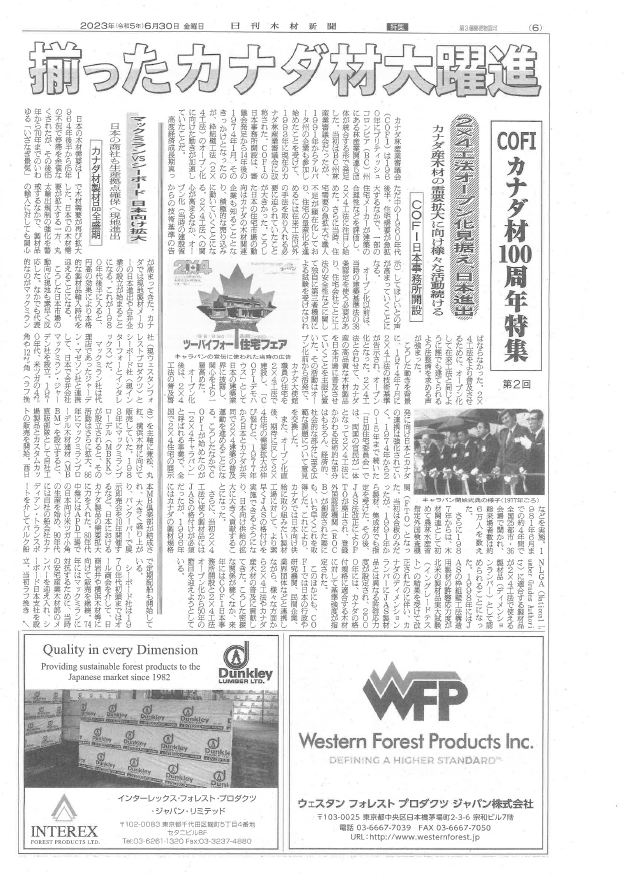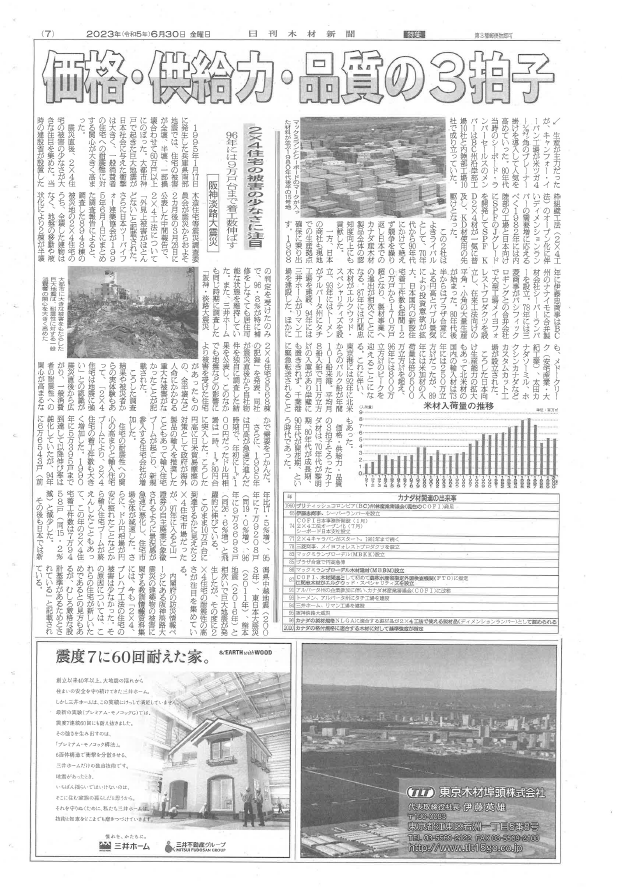Celebrating 100 Years of Wood Trade between Canada and Japan : Part II
The second article in the series commemorating the centenary of Canada-Japan timber trade which underscores Canada’s commitment to the Japanese market, was published on June 30th in the Nikkan Mokuzai newspaper (Daily Forest Products Journal). The first articles, released on May 30, covered the period from 1923-1970, while the second article delved into the years spanning 1974 to 2000.
The initial article outlined how the rapid expansion of the housing sector during 1960s and 1970s, fueled by robust economic growth, prompted home builders and the government to seek alternatives to the traditional post and beam (P&B) construction method. This led to the burgeoning interest in platform-frame construction (2×4). Against this backdrop, Canadian lumber companies had been actively marketing their products to Japan, and in January 1974 the COFI Japan Office was established to promote the 2×4 method and high-quality wood products from Canada. In July of the same year, the Japanese government implemented legislation that introduced technical standards, enabling 2×4 construction to be executed in a manner akin to traditional post and beam (P&B) methods. This pivotal initiative served as a milestone, opening up the market for 2×4 construction, which subsequently experienced a sustained upward trajectory in the following decades.


Following the development, Japan and Canada collaborated to enhance the awareness of the 2×4 method. This collaborative effort led to the culmination of the “2×4 Caravan”, a touring exhibition to demonstrate 2×4 construction across 25 cities and 36 venues throughout Japan. Over time, COFI has played a significant role in proliferating the 2×4 method and promoting of Canadian wood products by working with various Japanese governments, research institutes, industry groups and companies.

The 2nd article explores the commercial aspect of the Canada-Japan relationship through the 1970’s to 1990’s. Amidst the sale of Canadian products to Japan, Canadian companies encountered intense competition within their own ranks. This prompted many companies to establish joint ventures with Japanese partners as a strategic approach to market their products effectively. Initially mainly rough sawn hemlock from coastal BC mills dominated the market, but in the early 1980’s, to meet the demand for dimension lumber for 2×4 construction, J-grade SPF was developed by interior BC mills. This innovation, which pioneered the use of kiln-dried lumber, was an immediate success. Throughout this period, Japanese companies, initially trading firms and later wood importers, began acquiring or establishing their own mills in BC. With Canadian lumber offering competitive pricing, ample supply capacity and high quality, exports to Japan experience steady growth over the 30-year span.
The final article highlights how the aftermath of the massive Kobe earthquake in 1995 sparked increased consumer interest in the seismic resistance of housing. Surveys revealed that 2×4 homes in the impacted area displayed exceptional performance, sustaining minimal damage and avoided complete destruction. This helped spur further interest in the 2×4 method, prompting continued collaboration between COFI/Canada and Japan to further increase the performance of this system.
For those interested in receiving the translated articles, please contact the writer at [email protected].
The upcoming third set of articles, scheduled for next month, will focus on events from 2000 to the present. The articles will include topics on the improvements in quality and performance of Canadian wood products, Canada-Tohoku reconstruction projects after the earthquake and tsunami in 2011, and testing and development of new wood products for the Japanese market. The first two sets of articles have garnered positive reception, fueling our efforts to continue fostering awareness of Canada’s contributions to Japan’s construction industry.


